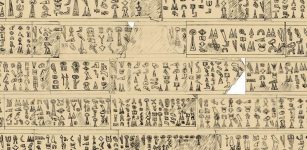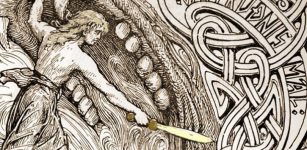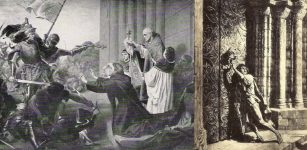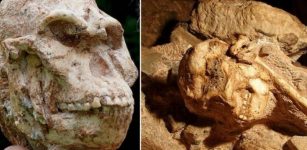Manticore – Legendary Persian Sphinx Whose Existence Is Still Discussed
Ellen Lloyd - AncientPages.com - Whenever the word “sphinx” is mentioned people automatically think about the Great Sphinx of Giza. It’s not surprising because it is today the most famous and admired sphinx of the ancient world. However, we shouldn’t forget there were other, very similar creatures that are today mostly forgotten.
One of them was the Manticore, the legendary sphinx of Persia.
Manticore in an illustration from the Rochester Bestiary (c.1230-1240). Credit: Public Domain
The Manticore was discussed by several ancient Greek authors, and this mysterious being has been depicted in western European Medieval art.
The Persian myth about the Manticore whose name means "man-eater" is very old. The Manticore was a bizarre creature that was said to have the body of a lion, the head of a man, bat wings, and the spiked tail of a scorpion. This combination made the Manticore extremely dangerous and the creature preyed not only on animals but also on humans.
“Originating in Persian mythology (modern Iraq) and documented by Greek naturalists, the manticore is described as having a keen appetite for humans and a howl like that of a trumpet.
The manticore’s morphology no doubt evolved out of necessity from the rugged terrain it occupied in Persia and the Middle East. It needed as many weapons as possible to both hunt a scarce food source and defend itself against predators. Preying on animals such as mountain goats and pigs, the manticore would find itself in human villages lured by the livestock. It is thought that the manticore began to feed on humans, developing a taste for such meat, thus establishing the lore of the man-eating manticore,” William O'Connor explains in Dracopedia The Bestiary.1
“The Manticore should not be confused with the Mantiger (or Mantyger) popular in medieval bestiaries, which had the body of a tiger, the head of a man and the feet of a monkey.”2
When Greek historians became interested in the Manticore, knowledge about this peculiar creature spread across Europe.
Manticore or mantyger badge of William, Lord Hastings, c.1470. Credit: Public Domain
Some, like for example Pausanias (110 – 180), a Greek traveler and geographer who lived during the reign of Roman Emperors Hadrian, Antoninus Pius, and Marcus Aurelius said he had seen many strange creatures in Rome, and among them was the Manticore.
“The beast described by Ctesias in his Indian history, which he says is called martichoras by the Indians and "man-eater" [androphagos] by the Greeks, I am inclined to think is the tiger. But that it has three rows of teeth along each jaw and spikes at the tip of its tail with which it defends itself at close quarters, while it hurls them like an archer's arrows at more distant enemies; all this is, I think, a false story that the Indians passed on from one to another owing to their excessive dread of the beast,” Pausanias wrote in Description of Greece.
Greek philosopher Apollonius of Tyana, (15 AD. - 100 AD.) was also interested in the Manticore and wanted to learn more about this magnificent but unusual animal.
According to Flavius Philostratus (c. 170–247), “Apollonius asked the question, whether there was there an animal called the man-eater (martichoras); and Iarchas replied: "And what have you heard about the make of this animal? For it is probable that there is some account given of its shape."
"There are," replied Apollonius, "tall stories current which I cannot believe; for they say that the creature has four feet, and that his head resembles that of a man, but that in size it is comparable to a lion; while the tail of this animal puts out hairs a cubit long and sharp as thorns, which it shoots like arrows at those who hunt it.” 3
It was through Pliny the Elder’s book Naturalis Historia the Manticore became famous in Medieval Europe. Descriptions and depictions of the Manticore varied and there was plenty of confusion about the nature and origin of this strange animal. In Inferno, part one of Dante Alighieri’s Divine Comedy, the mythical creature Geryon was depicted as a Manticore.
Woodcut from Edward Topsell's The Historie of Four-Footed Beasts (1607)
Today there is still a dispute about the existence of the Manticore. Some think it’s an extinct species, while others suggest the animal is an unknown type of tiger. One possibility is also that the Manticore could have been some sort of a Chimera, a monstrous Greek creature that was composed of several different animals.
Whatever the truth may be, the fact remains that the Manticore can still be encountered in more modern literature. For example, readers of George R.R. Martin's A Song of Ice and Fire books will remember how the author mentioned that Manticore venom is a very toxic poison.
Written by Ellen Lloyd – AncientPages.com
Copyright © AncientPages.com All rights reserved. This material may not be published, broadcast, rewritten or redistributed in whole or part without the express written permission of AncientPages.com
Expand for references- William O'Connor - Dracopedia The Bestiary: An Artist's Guide to Creating Mythical Creatures
- Jack Goldstein - 101 Amazing Mythical Beasts
- Flavius Philostratus, The Life of Apollonius of Tyana, translated by F. C. Conybeare, volume I, book III. Chapter XLV, pp. 327–329.
More From Ancient Pages
-
 Unexplained Mystery Of The Glowing Woman Who Baffled Scientists
Featured Stories | Jun 6, 2022
Unexplained Mystery Of The Glowing Woman Who Baffled Scientists
Featured Stories | Jun 6, 2022 -
 Mystery Greek tomb was dedicated to companion of Alexander – experts say
Civilizations | Oct 1, 2015
Mystery Greek tomb was dedicated to companion of Alexander – experts say
Civilizations | Oct 1, 2015 -
 Invasion Of Mysterious Sea People – Enigmatic 3,200-Year-Old Luwian Hieroglyphic Inscription Sheds New Light On Ancient Puzzle
Archaeology | Oct 11, 2017
Invasion Of Mysterious Sea People – Enigmatic 3,200-Year-Old Luwian Hieroglyphic Inscription Sheds New Light On Ancient Puzzle
Archaeology | Oct 11, 2017 -
 Magnificent Etruscan Underground Burial With Beautiful Artifacts Discovered In Aleria-Lamajone, France
Archaeology | May 13, 2022
Magnificent Etruscan Underground Burial With Beautiful Artifacts Discovered In Aleria-Lamajone, France
Archaeology | May 13, 2022 -
 Magnificent And Massive Great Wall Of India – Astonishing Ancient Structure Shrouded In Secrecy
Civilizations | Jul 7, 2015
Magnificent And Massive Great Wall Of India – Astonishing Ancient Structure Shrouded In Secrecy
Civilizations | Jul 7, 2015 -
 Cajamarca, Peru: Three Archaeological Sites – Identified
Archaeology | Aug 24, 2015
Cajamarca, Peru: Three Archaeological Sites – Identified
Archaeology | Aug 24, 2015 -
 Fenrir Killed At Ragnarok By Vidar Who Avenged His Father Odin’s Death
Featured Stories | Dec 10, 2018
Fenrir Killed At Ragnarok By Vidar Who Avenged His Father Odin’s Death
Featured Stories | Dec 10, 2018 -
 Unusual Mini Temples Discovered In Ancient Roman Camp In Haltern, Germany
Archaeology | Nov 16, 2023
Unusual Mini Temples Discovered In Ancient Roman Camp In Haltern, Germany
Archaeology | Nov 16, 2023 -
 Gigantic Kailasa Temple: Engineering Marvel Of India’s Master Builders
Featured Stories | Oct 17, 2020
Gigantic Kailasa Temple: Engineering Marvel Of India’s Master Builders
Featured Stories | Oct 17, 2020 -
 10 Divine Weapons Of The Gods
Featured Stories | Jul 28, 2015
10 Divine Weapons Of The Gods
Featured Stories | Jul 28, 2015 -
 Medieval Criminals Could Avoid Persecution By Claiming Sanctuary In Churches
Ancient History Facts | Mar 3, 2017
Medieval Criminals Could Avoid Persecution By Claiming Sanctuary In Churches
Ancient History Facts | Mar 3, 2017 -
 Largest Collection Of Ancient “Cup-Marked” Rocks Ever Found In Scotland
Civilizations | Nov 23, 2018
Largest Collection Of Ancient “Cup-Marked” Rocks Ever Found In Scotland
Civilizations | Nov 23, 2018 -
 DNA Breakthrough – New Human Gene Cluster Sequence Discovered
Evolution | Nov 24, 2023
DNA Breakthrough – New Human Gene Cluster Sequence Discovered
Evolution | Nov 24, 2023 -
 God’s Personal Flying Vehicle Described In ‘The Book of Ezekiel’
Biblical Mysteries | Jul 18, 2019
God’s Personal Flying Vehicle Described In ‘The Book of Ezekiel’
Biblical Mysteries | Jul 18, 2019 -
 How Did Sea Level Rise Impact Human Groups During Mesolithic And Neolithic Periods?
Archaeology | May 20, 2022
How Did Sea Level Rise Impact Human Groups During Mesolithic And Neolithic Periods?
Archaeology | May 20, 2022 -
 Porobonus – Mysterious Unknown Pagan God
Artifacts | Aug 28, 2015
Porobonus – Mysterious Unknown Pagan God
Artifacts | Aug 28, 2015 -
 Archaeologists Unearthed Alabaster Statue Of Queen Tiye In Luxor, Egypt
Archaeology | Mar 24, 2017
Archaeologists Unearthed Alabaster Statue Of Queen Tiye In Luxor, Egypt
Archaeology | Mar 24, 2017 -
 Does This Cathedral Offer Evidence Our Calendar Is ‘Missing’ 297 Years?
Featured Stories | May 6, 2022
Does This Cathedral Offer Evidence Our Calendar Is ‘Missing’ 297 Years?
Featured Stories | May 6, 2022 -
 Tile Tomb Dated To The Late Hellenistic Era – Discovered In Surroundings Of Istanbul, Turkey
Archaeology | Jun 6, 2022
Tile Tomb Dated To The Late Hellenistic Era – Discovered In Surroundings Of Istanbul, Turkey
Archaeology | Jun 6, 2022 -
 Skull Reveals Little Foot Was Capable Of Different Head Movements Than Modern Humans
Human Beginnings | Mar 25, 2020
Skull Reveals Little Foot Was Capable Of Different Head Movements Than Modern Humans
Human Beginnings | Mar 25, 2020



